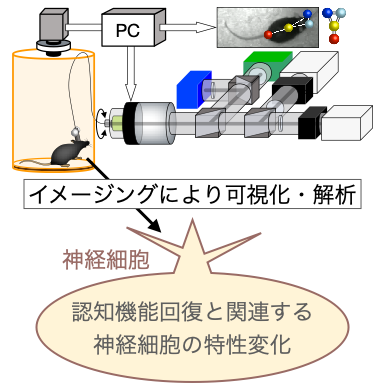Dai Watanabe

氏名Name
Dai Watanabe
所属・職名Affiliation, Title, etc.
Department of Biological Sciences, Graduate School of Medicine Kyoto University, Professor
研究室HPWebsite
一言メッセージShort Message
本プロジェクトでの研究概要Outline of the research in this project
We aim to establish an index for evaluating the “health status” of neurons that support the brain’s reservoir function, and to elucidate the cellular mechanisms that contribute to cognitive function recovery. Neurons continuously alter their properties, such as connectivity and excitability, in response not only to external stimuli but also to internal physiological and brain states. Using model animals, we will visualize and analyze changes in neuronal properties associated with cognitive recovery through advanced imaging techniques.
Furthermore, we will develop technologies to enhance the neuronal property changes that are expected to facilitate cognitive function recovery. We will assess whether these enhancements lead to improvements in cognitive function at the behavioral level in model animals, and establish innovative technologies for controlling neuronal cell property with potential applications in medicine.

これまで主な研究内容Outline of main research so far
“Elucidating the neural basis of cognitive flexibility using advanced imaging techniques.”
Our real-world is composed of numerous elements and continuously changing. Considering all these environmental factors to make decisions or find optimal solutions far exceeds computational capacity of the brain. To overcome this difficulty, the brain narrows down the relevant elements and forms an internal model of the external environment based on limited information. As a result, we are able to act quickly, flexibly, and appropriately in response to our environment. However, the details of how internal models are formed in the brain and how they influence our decisions have remained unclear. To address this question, we have developed advanced imaging technologies and are uncovering how internal models are constructed and reflected in behavior.

主な経歴・受賞歴等Career, Awards, etc.
Career
- 1993-1997
- Graduate Student, Graduate School of Medicine, Kyoto University
- 2000
- PhD
- 1997-2003
- Assistant Professor, Department of Biological Sciences, Graduate School of Medicine, Kyoto University
- 2003-2005
- Research Fellow, California Institute of Technology
- 2005-2006
- Vice Head of Department, Department of Systems Biology, Osaka Bioscience Institute
- 2006-2014
- Professor, Graduate School of Biostudies and Graduate School of Medicine, Kyoto University
- 2014
- Professor, Graduate School of Medicine, Kyoto University
Award
- 2013
- MEXT Commendations for Science and Technology, Awards for Science and Technology
主要業績Major Publications
Okunomiya, T., Watanabe, D., Banno, H., Kondo, T., Imamura, K., Takahashi, R., and Inoue, H. (2025). Striosome Circuitry Stimulation Inhibits Striatal Dopamine Release and Locomotion. J. Neurosci. 45, e0457242024.
https://doi.org/10.1523/jneurosci.0457-24.2024.
Ohmori, H., Hirai, Y., Matsui, R., and Watanabe, D. (2023). High resolution recording of local field currents simultaneously with sound-evoked calcium signals by a photometric patch electrode in the auditory cortex field L of the chick. J Neurosci Meth 392, 109863.
https://doi.org/10.1016/j.jneumeth.2023.109863.
Hamaguchi, K., Takahashi-Aoki, H., and Watanabe, D. (2022). Prospective and retrospective values integrated in frontal cortex drive predictive choice. Proc National Acad Sci 119, e2206067119.
https://doi.org/10.1073/pnas.2206067119.
Sotoyama, H., Namba, H., Kobayashi, Y., Hasegawa, T., Watanabe, D., Nakatsukasa, E., Sakimura, K., Furuyashiki, T., and Nawa, H. (2021). Resting-state dopaminergic cell firing in the ventral tegmental area negatively regulates affiliative social interactions in a developmental animal model of schizophrenia. Transl Psychiat 11, 236.
https://doi.org/10.1038/s41398-021-01346-2.
Okunomiya, T., Hioki, H., Nishimura, C., Yawata, S., Imayoshi, I., Kageyama, R., Takahashi, R., and Watanabe, D. (2020). Generation of a MOR‐CreER knock‐in mouse line to study cells and neural circuits involved in mu opioid receptor signaling. genesis 58, e23341.
https://doi.org/10.1002/dvg.23341.
Abe, K., Matsui, S., and Watanabe, D. (2015). Transgenic songbirds with suppressed or enhanced activity of CREB transcription factor. Proc National Acad Sci 112, 7599 7604.
https://doi.org/10.1073/pnas.1413484112.
Matsui, R., Tanabe, Y., and Watanabe, D. (2012). Avian adeno-associated virus vector efficiently transduces neurons in the embryonic and post-embryonic chicken brain. Plos One 7, e48730.
https://doi.org/10.1371/journal.pone.0048730.
Kinoshita, M., Matsui, R., Kato, S., Hasegawa, T., Kasahara, H., Isa, K., Watakabe, A., Yamamori, T., Nishimura, Y., Alstermark, B., Watanabe, D., and Isa, T. (2012). Genetic dissection of the circuit for hand dexterity in primates. Nature 487, 235 238.
https://doi.org/10.1038/nature11206.
Fujimoto, H., Hasegawa, T., and Watanabe, D. (2011). Neural coding of syntactic structure in learned vocalizations in the songbird. J Neurosci 31, 10023 10033.
https://doi.org/10.1523/jneurosci.1606-11.2011.
Abe, K., and Watanabe, D. (2011). Songbirds possess the spontaneous ability to discriminate syntactic rules. Nat Neurosci 14, 1067 1074.
https://doi.org/10.1038/nn.2869.



